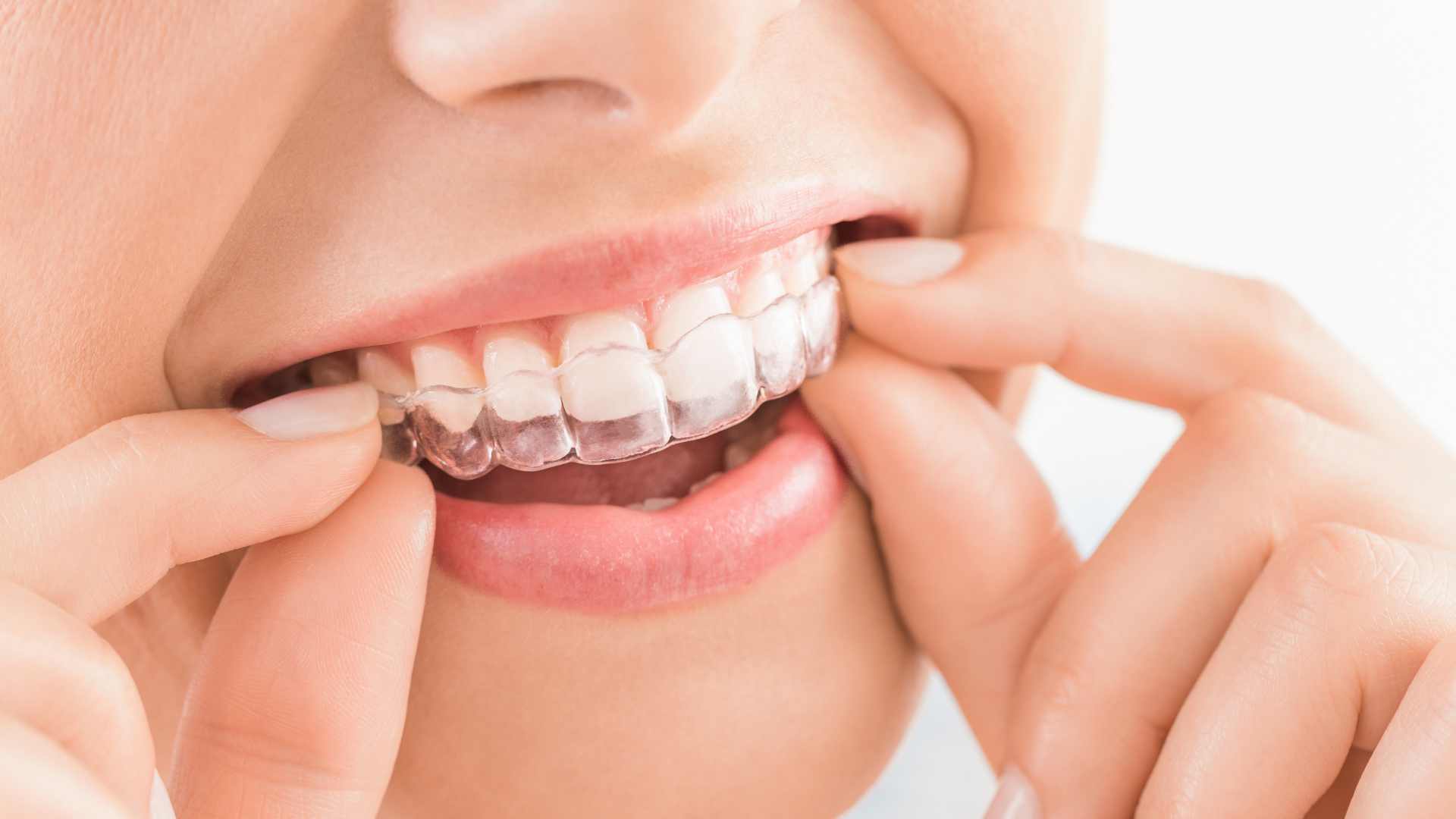Are you considering straightening your teeth but need to know if traditional braces are right for you? You may have heard about Invisalign, a popular alternative to metal braces that uses clear aligners to gradually shift teeth into their desired position. But how much are Invisalign in Canada?
Whether you’re a teenager or an adult seeking orthodontic treatment, it’s important to understand the cost of Invisalign and how it compares to traditional braces. In this article, we will explore the average prices of Invisalign in Canada, discuss the benefits of this treatment option, and help you make an informed decision between Invisalign and braces.
So, if you’ve been wondering about the cost of Invisalign or whether it’s the right option for you, keep reading to find out all the information you need to make an informed decision about your dental health.
What is Invisalign?

Invisalign is a revolutionary orthodontic treatment that uses a series of clear, removable aligners to gradually straighten teeth without the use of traditional metal braces.
The Invisalign system involves a customized treatment plan created by an Invisalign-trained orthodontist, who will prescribe a sequence of removable aligners that are worn for about two weeks each before progressing to the next set.
Overview of Invisalign Treatment
Unlike traditional braces, Invisalign aligners are virtually invisible, allowing patients to feel confident about their appearance during treatment. They are also removable, which makes it easier to maintain good oral hygiene by brushing and flossing as normal.
While both Invisalign and braces aim to achieve the same goal of straighter teeth, the Invisalign system offers additional benefits such as improved comfort and convenience.
Invisalign vs. Traditional Braces
The Invisalign treatment cost in Canada can be comparable to the cost of traditional braces, which typically range from $3,000 to $6,000. However, the cost comparison between Invisalign and traditional braces can vary depending on the complexity of the case and the provider’s expertise. Many patients find the benefits of Invisalign, such as the discreet appearance and removable design, to be worth the investment.
How Much Are Invisalign in Canada?
The average cost of Invisalign treatment in Canada ranges from $3,000 to $8,000, with the typical cost falling between $3,500 and $8,500.
However, the exact cost can vary significantly depending on several factors, including the patient’s geographical location, the severity of their dental issues, the projected treatment duration, and the experience and expertise of the Invisalign provider.
Patients are encouraged to consult with an Invisalign-trained professional to obtain a personalized cost estimate based on their individual needs and treatment plan.
Cost Factors for Invisalign in Canada

The cost of Invisalign treatment in Canada can vary significantly due to several key factors. Based on the analysis of the provided websites, here’s a cost breakdown for Invisalign in Canada in 2024:
| Factor | Cost Range (CAD) | Notes |
|---|---|---|
| Base Cost of Invisalign | $3,000 – $8,000 | The overall cost can vary significantly depending on the complexity of the case and location. |
| Initial Consultation | Free – $500 | Some clinics offer free consultations, while others may charge a fee. |
| Insurance Coverage | $2,000 – $3,000 | If covered, insurance may reduce the cost by this amount. |
| Monthly Payment Plans | Starting at $200/month | Some clinics offer flexible payment options to make treatment more affordable. |
| Additional Costs (Retainers, etc.) | Varies | Retainers, teeth whitening, and other add-ons may incur extra charges. |
Key Points:
- Location and Provider: The cost of Invisalign can vary depending on the city and the expertise of the provider. For instance, prices in Vancouver tend to range from $5,500 to $7,900.
- Complexity of Treatment: More complex cases may require longer treatment times, increasing the overall cost.
- Insurance: Many dental insurance plans cover part of the cost, typically up to $3,000.
- Payment Plans: Monthly payment plans are available at many clinics, starting at approximately $200 per month.
Comparing Costs: Invisalign vs. Traditional Braces

When comparing the costs of Invisalign and traditional braces in Canada, the two treatments are generally comparable. The average cost of traditional braces ranges from $3,000 to $6,000, which is similar to the $3,000 to $8,000 range for Invisalign. However, it’s important to note that the specific cost for each patient can vary depending on the complexity of their case, the provider’s experience, and other factors.
While Invisalign may be slightly more expensive in some cases, the treatment’s benefits, such as improved comfort, convenience, and aesthetic appeal, may outweigh the cost difference for many patients. Ultimately, the decision between Invisalign and traditional braces should be based on the patient’s individual needs, preferences, and the recommendation of their Invisalign-trained orthodontist.
Treatment Cost Comparison:
| Treatment | Average Cost Range (CAD) |
|---|---|
| Invisalign | $3,000 – $8,000 |
| Traditional Braces | $3,000 – $6,000 |
Paying for Invisalign Treatment

Financing your Invisalign treatment in Canada doesn’t have to be a daunting task. There are several options available to make the cost more manageable, including insurance coverage, health spending accounts, and payment plans from dental providers.
1. Insurance Coverage
Many dental insurance plans in Canada provide coverage for orthodontic treatments like Invisalign. Some plans can cover up to 50% of the cost, making the treatment more affordable for patients. It’s important for Canadians to check with their insurance provider to determine the level of coverage available for Invisalign.
2. Health Spending Accounts
Health spending accounts (HSAs) offer another avenue for Canadians to finance their Invisalign treatment. These accounts allow individuals to set aside pre-tax dollars to cover medical expenses not covered by the Canadian Universal Health Care system, including Invisalign treatment.
3. Payment Plans from Dental Providers
Many dental providers in Canada offer flexible payment plans to help make Invisalign more accessible. These plans allow patients to spread the cost of their treatment over the duration of their treatment, making it more manageable and achievable.
By exploring these various financing options, Canadians can make Invisalign a more accessible and viable choice for their orthodontic needs.
Benefits of Invisalign

Invisalign offers several key benefits that make it an attractive alternative to traditional braces. The clear, virtually invisible aligners allow patients to feel confident about their appearance during treatment, as the aligners are barely noticeable in the mouth.
Invisalign aligners are also removable, which makes it easier for patients to maintain good oral hygiene by brushing and flossing as usual, and to enjoy their favorite foods without restrictions.
Additionally, the aligners are made from a comfortable SmartTrack material that is designed for predictability and patient comfort.
While there may be some minor discomfort associated with tooth movement, Invisalign is generally considered a more comfortable treatment option compared to traditional braces.
These benefits make Invisalign an appealing choice for many patients seeking a discreet and convenient orthodontic solution.
Key Benefits:
- Virtually Invisible Aligners: The clear, virtually invisible aligners used in Invisalign treatment allow patients to feel confident and self-assured during the orthodontic process, without the aesthetic concerns associated with traditional metal braces.
- Removable for Eating and Cleaning: Invisalign’s removable design allows patients to continue enjoying their favorite foods without dietary restrictions and makes it easier to maintain good oral hygiene.
- Comfortable SmartTrack Material: The aligners are designed using a proprietary SmartTrack material for both predictability and patient comfort, causing less irritation compared to traditional braces.
Candidate Eligibility for Invisalign
Invisalign is suitable for a wide range of patients, from teens to adults, who are looking to straighten their teeth and improve their smile. The treatment is designed to address a variety of orthodontic issues, including overbite, underbite, crowding, spacing, and alignment problems.
During the initial consultation, the Invisalign-trained orthodontist will assess the patient’s dental condition and determine if Invisalign is the appropriate treatment option.
Factors such as the severity of the patient’s misalignment and their willingness to wear the aligners as prescribed will be taken into consideration. In general, Invisalign can be an effective solution for most patients seeking to achieve a straighter, healthier smile.
Treatment Duration of Invisalign
The duration of Invisalign treatment can vary depending on the complexity of the patient’s case and the degree of tooth movement required. In mild cases, the treatment can be as short as six months, but the average treatment time is typically 12 to 18 months. However, patients may begin to see noticeable improvements in their smile within just a few weeks of starting Invisalign.
The key to achieving the best results is for patients to wear their aligners for the recommended 20 to 22 hours per day, only removing them for eating, drinking, and oral hygiene. By following the treatment plan prescribed by their Invisalign-trained orthodontist, patients can ensure their teeth move in the right direction and reach the desired outcome in the expected timeframe.
Finding the Right Invisalign Provider

When seeking Invisalign treatment, it’s crucial for patients to find the right provider who possesses the necessary experience and expertise to deliver successful results. Experienced Invisalign-trained orthodontists, who have completed specialized training and have a track record of positive patient outcomes, may charge higher fees but can provide more personalized and effective treatment plans.
1. Experience and Expertise
These providers ensure the Invisalign process goes smoothly and prioritize the patient’s best interests, which can lead to better long-term results. While the cost may be higher with an experienced provider, it can be a worthwhile investment in achieving the desired smile transformation
2. Personalized Treatment Plans
Patients should carefully research and compare providers to find the one best suited to their needs and budget. An Invisalign-trained orthodontist who can develop a personalized treatment plan tailored to the individual’s unique dental condition is more likely to deliver the what is the success rate of invisalign? outcomes.
Invisalign for Teenagers
Invisalign is a popular orthodontic treatment option for teenagers, offering several benefits that appeal to this age group. The clear, virtually invisible aligners allow teenagers to feel confident and self-assured during the treatment process, without the aesthetic concerns associated with traditional metal braces.
Invisalign’s removable design also makes it easier for teenagers to maintain good oral hygiene and enjoy their favorite foods, as the aligners can be taken out for short periods.
Additionally, the treatment duration for Invisalign is often shorter than that of braces, which can be an important consideration for teenagers with upcoming social events or milestones.
By providing a discreet and convenient orthodontic solution, Invisalign can be an attractive choice for teenagers seeking to improve their smile and boost their self-esteem.
Conclusion
In conclusion, Invisalign presents a compelling alternative to traditional braces for those seeking a discreet and effective way to straighten their teeth. With costs ranging from $2,000 to $8,000 typically between $3,500 and $8,500 several factors such as location, treatment complexity, and provider experience can influence the final price.
Financing options, including insurance coverage, health spending accounts, and flexible payment plans, can help make Invisalign more accessible. Many patients find the investment worthwhile due to Invisalign’s benefits, such as its virtually invisible aligners and comfortable design.
While $5,000 may seem significant, the advantages of Invisalign often justify the cost. With professional guidance, patients can determine if Invisalign suits their needs and budget. Although some minor discomfort might occur, Invisalign is generally more comfortable than traditional braces.




